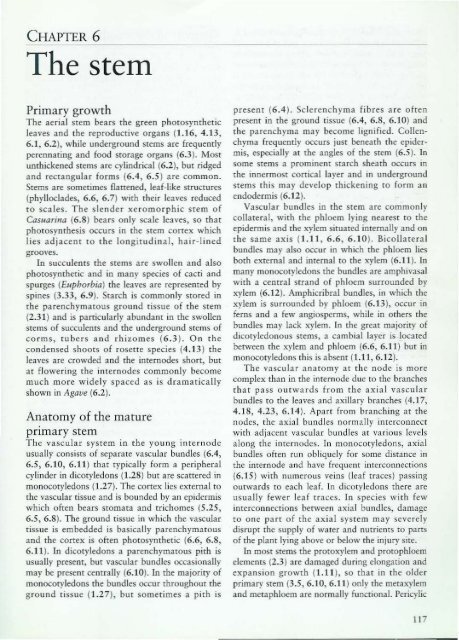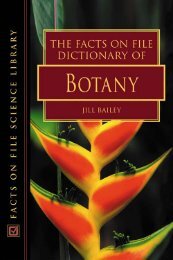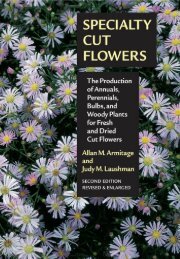Create successful ePaper yourself
Turn your PDF publications into a flip-book with our unique Google optimized e-Paper software.
CHAPTER 6<br />
The stem<br />
Primary growth<br />
The aerial stem bears the green photosynthetic<br />
leaves and the reproductive organs (1.16,4.13,<br />
6.1, 6.2), while underground stems are frequently<br />
perennating and food storage organs (6.3). Most<br />
unthickened stems are cylindrical (6.2), but ridged<br />
and rectangular forms (6.4, 6.5) 3rc common.<br />
Stems are sometimes flattened, leaf-like structures<br />
(phylloclades, 6.6, 6.7) with their leaves reduced<br />
to scales. The slender xcromorphic stem of<br />
Casuarina (6.8) bears only scale leaves, so that<br />
phorosynrhesis occurs in the stem cortex which<br />
lies adjacent to the longitudinal, hair-lined<br />
grooves.<br />
[n succulents the stems are swollen and also<br />
photosynthetic and in many species of cacti and<br />
spurges (Euphorbia) the leaves 3rc rcpresenred by<br />
spines (3.33, 6.9). Starch is commonly stored in<br />
the parenchymatous ground tissue of the stem<br />
(2.31) and is particularly abundant in the swollen<br />
stems of succulents and the underground stems of<br />
corms, tubers and rhizomes (6.3). On the<br />
condensed shoots of rosette species (4.13) the<br />
lea\'es are crowded and the internodes short, bur<br />
at flowering the internodes commonly become<br />
much more widely spaced as is dramatically<br />
shown in Agave (6.2).<br />
Anatomy of the mature<br />
pnmary stem<br />
The vascular system in the young internode<br />
usually consists of separate vascular bundles (6.4,<br />
6.5, 6.10, 6.11) that typically form a peripheral<br />
cylinder in dicotyledons (1.28) but are scattered in<br />
monocotyledons (1.27). The cortex lies external to<br />
rhe vascular tissue and is bounded by an epidermis<br />
which often bears stomata and trichomes (5.25,<br />
6.5, 6.8). The ground tissue in which the vascular<br />
tissue is embedded is basically parenchymatous<br />
and the cortex is often photosynthetic (6.6, 6.8,<br />
6.11). in dicotyledons a parenchymatous pith is<br />
usually presenr, but vascular bundles occasionally<br />
may be present centrally (6.10). In the majority of<br />
monocotyledons the bundles occur throughout the<br />
ground tissue (1.27), but sometimes a pith is<br />
present (6.4). Sclerenchyma fibres are often<br />
present in the ground tissue (6.4, 6.8, 6.10) and<br />
the parenchyma may become lignified. Collen·<br />
chyma frequently occurs JUSt beneath the epider·<br />
mis, especially at the angles of the stem (6.5). In<br />
some stems a prominent starch sheath occurs in<br />
the innermOSt cortical layer and in underground<br />
stems this may develop thickening to form an<br />
endodermis (6.12).<br />
Vascular bundles in the stem are commonly<br />
collateral, with the phloem lying nearest to the<br />
epidermis and the xylem situated internally and on<br />
the same axis (1.11, 6.6, 6.10). Bicollateral<br />
bundles may also occur in which the phloem lies<br />
both external and internal to the xylem (6.11). in<br />
many monocotyledons the bundles are amphivasal<br />
with a cenrral strand of phloem surrounded by<br />
xylem (6.12). Amphicribral bundles, in which the<br />
xylem is surrounded by phloem (6. t3), occur in<br />
ferns and a few angiosperms, while in others the<br />
bundles may lack xylem. In the great majority of<br />
dicotylcdonous stems, a cambial layer is located<br />
betwcen the xylem and phloem (6.6, 6.11) but in<br />
monocotyledons this is absent (1.11, 6.12).<br />
The vascular anatomy at the node is more<br />
complex than in the internode due to the branches<br />
that pass outwatds from the axial vascular<br />
bundles to the leaves and axillary branches (4.17,<br />
4.18,4.23, 6.14). Apart from branching at the<br />
nodes, the axial bundles normally interconnect<br />
with adjacent vascular bundles at various levels<br />
along the internodes. In monocotyledons, axial<br />
bundles often run obliquely for some distance in<br />
the internode and have frequent interconnections<br />
(6.15) with numerous veins (leaf traces) passing<br />
outwards to each leaf. In dicotyledons there are<br />
usually fewer leaf traces. In species with few<br />
interconnections between axial bundles, damage<br />
to one part of the axial system may severely<br />
disrupt the supply of water and nutrients to parts<br />
of the plant lying above or below the injury site.<br />
In most stems the protoxylem and protophloem<br />
elementS (2.3) 3re damaged during elongation and<br />
expansion growth (1.11), so that in the oldet<br />
primary stem (3.5, 6.10, 6.11) only the metaxylem<br />
and mctaphloem are normally functional. Pericylic<br />
117





